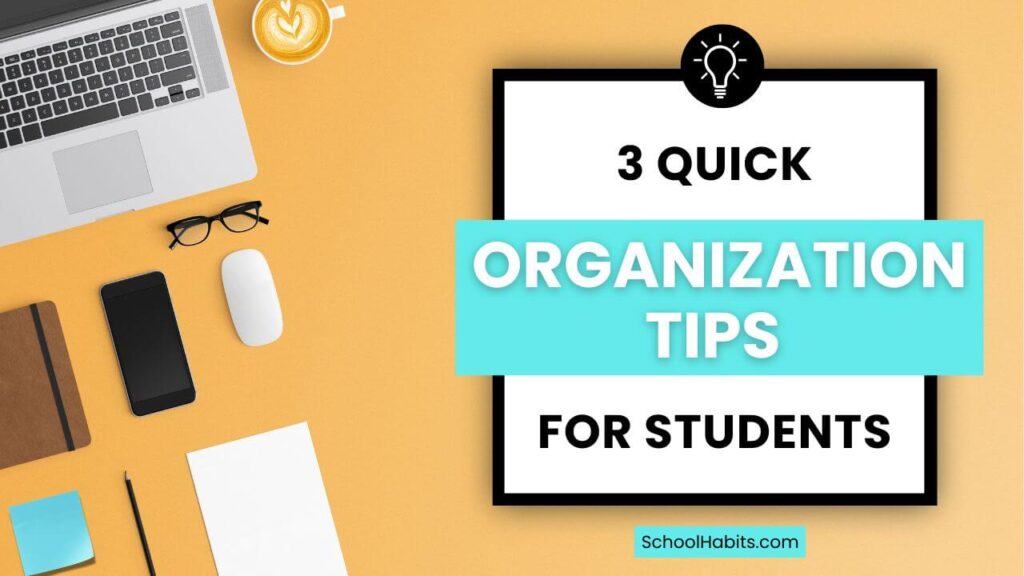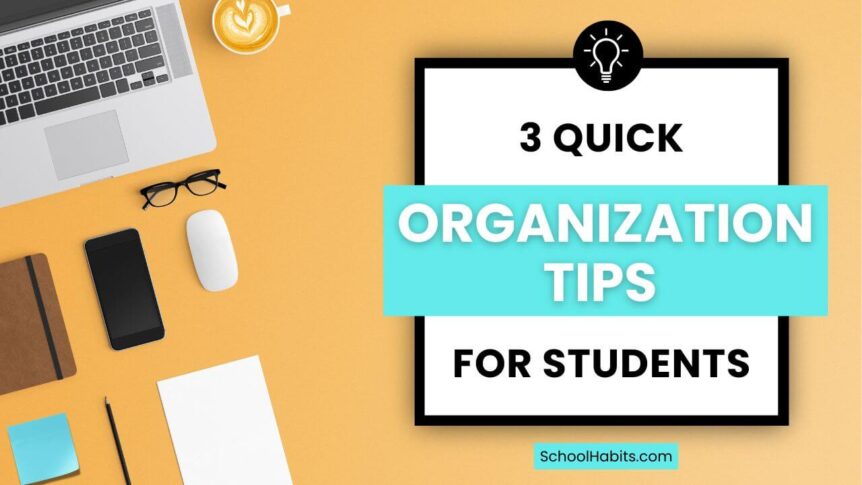
By Katie Azevedo, M.Ed.
Disorganization can make everything around you feel out of control. You don’t know where things are, you don’t know when assignments are due, and your external environment signals chaos.
The opposite is also true. When we’re at least somewhat organized, everything around us feels a little easier. A little calmer. A little better.
Don’t get me wrong. There’s a time and place for overhauling your study space and your entire digital filing system, but that’s not what you’re going to get out of this article.
This article is about quick wins, instant gratification, and real payoff. It contains three quick organization tips for high school and college students.
Keep It Simple: 10 Minutes Per Task Is All You Need
The next time you feel overwhelmed with school and like everything’s out of control, I want you to set aside just 30 minutes to organize the three areas outlined below.
You could also break up the tasks into three 10-minute chunks spread out over an afternoon or a few days.
The point is that I want you to keep each of the three organization efforts to 10 minutes or under. Otherwise, they’re no longer quick — as promised by the title of this blog post.
If you’re not yet convinced that spending just 10 minutes on the following three areas is powerful enough to make school feel easier, then I want you to read this article: How Disorganization Makes Everything Harder. In that article, I explain how being disorganized affects more parts of your school life than you probably realize.
3 Quick Organization Tips for High School and College Students
These organization tips aren’t complicated systems or time-consuming routines. They’re small organizing tasks that give you quick wins — and that’s the whole point. Each one takes about 10 minutes and pays off immediately.
1. Your Backpack and Folders
A cluttered and disorganized backpack makes your school life so much harder than it needs to be. Every time you reach into your bag, you’re not only reminded of the chaos but you also can’t find what you need when you need it. That’s not cool.
Here’s What To Do:
- Throw away obvious trash like food wrappers.
- Remove clothing from your bag and put it in the wash (who doesn’t have a scrunched up hoodie in their backpack?)
- Take out all the loose papers — even the crinkled ones — and either throw them away or put them in the right folders.
- Straighten the papers in your folders and binders so they’re not hanging out the side.
- Restock pens, highlighters, or sticky notes as needed.
Why It Works:
A clean backpack with organized folders obviously makes it easier to find what you need when you need it. But more than that, an organized backpack lowers your resistance to opening up your bag and pulling out what you need to do your work. (This means less procrastination.)
A tidy bag also makes it easier to put your things away when you’re done with them because your folders are easy to access. In 10 minutes or less, you can eliminate one of the strongest sources of visual chaos in your “school life” — and this outer calm can bring you inner calm.
Here are my best backpack organization tips.
2. Your To-Do List
An unorganized task list causes procrastination, decision fatigue and mental clutter. When you don’t know what’s due or what you should be working on, you feel stressed AND you don’t do the work at all.
I talk a lot about building a foundational task management system in this blog post and in the podcast below. (Have you heard my Learn and Work Smarter podcast? It’s literally exactly for you.) If you don’t yet have a good way to track and manage your homework assignments other than your learning management system, I suggest you check out those resources.
However, remember our mission here: to be quick and get some instant gratification. So for this organization tip, I’d rather you spend just 10 minutes getting clear on your top five most immediate tasks, rather than building a task management system from scratch.
Here’s What to Do:
- Get a piece of paper and a pen.
- Open up your learning management system.
- Go into each class and choose one top priority assignment. Yes, just one per class, even if you have a million.
- Write those assignments on your paper.
If you have seven classes, your list will probably have seven assignments on it. Yes, you probably have more assignments in your learning management system, but that’s not the point of this exercise.
What we’re doing here is a quick pass over the things you need to do, and identifying the most urgent. That’s it. It’s not ignoring the other assignments; it’s simply taming the disorganization into something manageable.
Why It Works:
A clean list helps your brain prioritize. You’ll feel less overwhelmed just by seeing your tasks clearly laid out in front of you. And when you’re less overwhelmed, you’re more likely to start.
Even if you don’t finish the tasks right away, knowing what’s on your plate gives you back a sense of control. And remember: it’s the sense of control that brings us a sense of calm.
3. Your Email Inbox
Email chaos is sneaky. It’s easy to ignore until it explodes. And let’s be real: when our email inbox is TOO disorganized, it can feel impossible to fix — so we do nothing.
Even if you’re not someone who sends a lot of emails, your inbox still matters, especially in high school and college. Teachers, professors, school admins, coaches, and club leaders often communicate through email. That means important reminders, deadlines, and opportunities are probably sitting in your inbox right now.
If you ignore your email because it feels chaotic, you’re not alone. But that chaos can cost you — missed assignments, late responses, or feeling constantly behind. It’s totally normal for email to feel overwhelming, but it’s also totally fixable.
If you want to go deeper into managing your inbox, check out my blog post: How to Manage Email as a Student and my podcast episode Email Management Tips: 3 Best Practices for Handling Your Inbox. Both will help you create a simple email routine that you can carry with you into your future job.
Here’s What to Do:
- Delete or archive anything you don’t need.
- Respond to anything you can reply to in a few sentences or less.
- Star or flag important messages you still need to act on.
- Pull important “action items” from emails and put those action items in your task management system.
- Pull deadline-based information from emails and put those dates on your calendar.
Why It Works:
An organized inbox means fewer missed deadlines and less low-key anxiety. In the case of emails, ignorance is NOT bliss. By clearing the clutter and flagging important info, you make your inbox work for you, not against you.
Even just 10 minutes of clean-up can help you feel caught up, clear, and more organized.
Final Notes About Quick Organization Tips for Students
Disorganization can make everything harder, so it’s not just in your head if you’ve been feeling frazzled or behind. Your environment, your tasks, and your inbox all affect your focus and your energy.
The good news? You don’t need to be a super-organized person to feel in control. You don’t need to have labeled folders and color-coded notes to feel like you’ve got your act together. You don’t need a perfect system to feel calm and capable.
Setting a timer for just 10 minutes can give you way more than 10 minutes of peace, motivation, and clarity.
Looking for more ways to feel organized and in control? Check out my top organization resources:
- 7 Note Organization Ideas
- How to Get Organized for Final Exams
- 100 Organization Tips for Students
- How to Organize a School Binder

